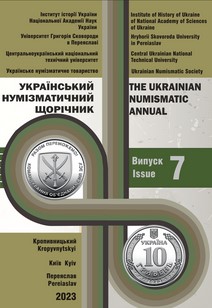СКАРБОЗНАВСТВО ЯК ГАЛУЗЬ НУМІЗМАТИКИ
TREASURE STUDIES AS A BRANCH OF NUMISMATIC
Author(s): Oleksandr PotylchakSubject(s): Economic history, Methodology and research technology
Published by: ДВНЗ Переяслав-Хмельницький державний педагогічний університет імені Григорія Сковороди
Keywords: coins; treasures; numismatics; numismatic treasure studies;
Summary/Abstract: The purpose of the article is the theoretical problems of treasure studies as a branch of numismatics. Scientific novelty. The author's definition of the concept of «numismatic treasure studies» has been proposed. The author outlined its object and subject, tasks and functions in numismatics, considered and typologized the source base of hoarding studies, systematized the concepts and terms of numismatic treasure studies, determined its place in the system of numismatics and traced intersubject connections. Conclusions. The current state of treasure studies objectively proves that hoard studies «has outgrown» the status of an applied method and has acquired the features of a self-sufficient branch of numismatic science with its object and subject, tasks and methods of researching coin treasures, a specific and constantly replenished source base, a conceptual and categorical apparatus and a system of interdisciplinary connection. Numismatic treasure studies is a branch of numismatic science that examines coin treasures as sources of social, economic, political and other various information, their origin, typology, functions, history of research, develops methodology and methods of studying coin thesauri. At the current stage of the development of world and domestic numismatics, the study of coin treasures has become a key trend in the development of this science. The object of research of numismatic treasure studies is the coin treasure as a historical source and sociocultural phenomenon. The subject of numismatic treasure studies is historical, economic and social patterns, reasons and motives for the appearance of coin hoards as a special type of deposits, the theory of hoarding, history of the study of treasure of different chronological periods, methodology and methods of their research. At the present stage, the scope of tasks of numismatic treasure studies includes theoretical and practical problems. In particular, among the theoretical tasks of this branch of numismatics, we can highlight: the development of basic concepts and categories related to the study of coin hoards and coin complexes; study of the theory of thesaurization in numismatics, study of the role and functions of coin treasures, prerequisites, reasons and motives for their concealment in different historical periods; development of methodology and methods of attribution and research of coin treasures as sources of numismatics, history of money circulation, social and political history. Among its practical tasks of numismatic hoarding, it is worth highlighting: improvement of scientific methodological techniques and means of studying and using treasures, development of methods of their source criticism; analytical and informational study of coins or coin complexes; development of methods for evaluating the scientific, historical and cultural significance (value) of coin and coin-material treasures; study of the problems of preservation and legal protection of treasures as monuments of history and culture. The two most important functions of numismatic treasure studies derive from this range of scientific tasks: heuristic and analytical. Treasure science forms its base of documentary and narrative sources, the basis of which is made up of coin treasures or other integral complexes of numismatic finds. The group of narrative sources of numismatic hoarding includes topographies of numismatic finds, corpora and catalogues of known treasures, short scientific reports on their discovery, publications with descriptions of found coin and coin-material treasures, studies of individual treasures and numismatic complexes, field descriptions and reports of archaeological expeditions from data on found coin and coin-material treasures, materials from newspapers and magazines with notes and reports on found treasures; epistolaries, diaries and memoirs of archaeologists, numismatists, travellers, treasure hunters, network resources of electronic Internet auctions. The conceptual and terminological apparatus of treasure studies was formed in the framework of the subject of numismatics and today represents part of the concepts and terms of this special branch of historical science. Functionally, three groups are logically distinguished in the structure of concepts and categories of hoarding. The first group includes the main categories like «treasure», «coin-material treasure», «coin treasure» and «coin complex». The second group of terms refers to the regulation of the occurrence of treasures and the nature and composition of coin thesauruses. The third group of terms is outlined by the research methodology of coin and coin-material finds. As a constituent part of numismatics, treasure studies belong to the system of historical science and has constant subject connections with a number of related disciplines like archaeology, source studies, museology, historical heritage studies, bonistics, sphragistics, heraldry, historical geography and cartography, epigraphy, palaeography, historical metrology and chronology.
Journal: Український Нумізматичний Щорічник
- Issue Year: 2023
- Issue No: 7
- Page Range: 221-246
- Page Count: 26
- Language: Ukrainian

